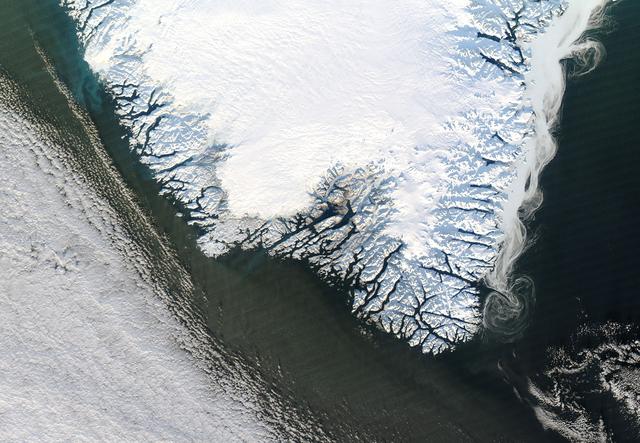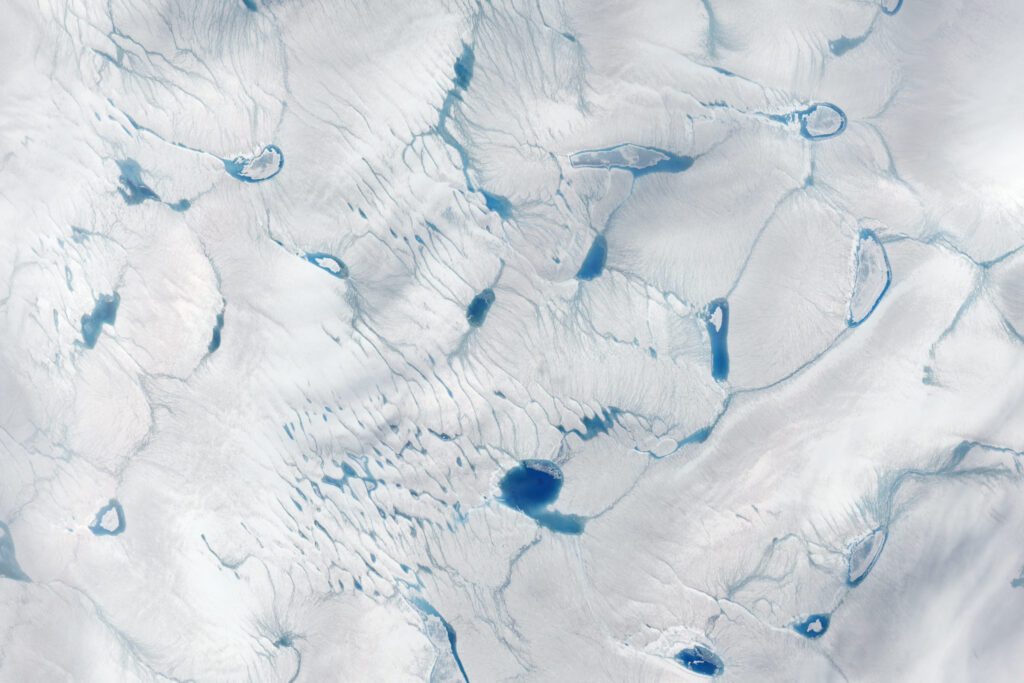Once we emit about 1000 gigatons of carbon, much of the massive ice sheet will melt irreversibly. We’ve emitted 500 gigatons so far.
27 March 2023

Much of the southern Greenland Ice Sheet, shown here, will melt irreversibly if we emit about 1000 gigatons of carbon, according to models in a new Geophysical Research Letters study. Credit: NASA GSFC
AGU press contact:
Rebecca Dzombak, +1 (202) 777-7492, [email protected] (UTC-4 hours)
Contact information for the researchers:
Dennis Höning, Potsdam Institute for Climate Impact Research, [email protected] (UTC+1 hour)
WASHINGTON — The Greenland Ice Sheet covers 1.7 million square kilometers (660,200 square miles) in the Arctic. If it melts entirely, global sea level would rise about 7 meters (23 feet), but scientists aren’t sure how quickly the ice sheet could melt. Modeling tipping points, which are critical thresholds where a system behavior irreversibly changes, helps researchers find out when that melt might occur.
Based in part on carbon emissions, a new study using simulations identified two tipping points for the Greenland Ice Sheet: releasing 1000 gigatons of carbon into the atmosphere will cause the southern portion of the ice sheet to melt; about 2500 gigatons of carbon means permanent loss of nearly the entire ice sheet.
Having emitted about 500 gigatons of carbon, we’re about halfway to the first tipping point.
“The first tipping point is not far from today’s climate conditions, so we’re in danger of crossing it,” said Dennis Höning, a climate scientist at the Potsdam Institute for Climate Impact Research who led the study. “Once we start sliding, we will fall off this cliff and cannot climb back up.”
The study was published in AGU’s journal Geophysical Research Letters, which publishes short-format, high-impact research spanning the Earth and space sciences.

When Greenland’s ice sheet melts, it loses elevation and is exposed to warmer air. The warmer air then increases melt further. Credit: NASA GSFC
The Greenland Ice Sheet is already melting; between 2003 and 2016, it lost about 255 gigatons (billions of tons) of ice each year. Much of the melt to date has been in the southern part of the ice sheet. Air and water temperature, ocean currents, precipitation and other factors all determine how quickly the ice sheet melts and where it loses ice.
The complexity of how those factors influence each other, along with the long timescales scientists need to consider for melting an ice sheet of this size, make it difficult to predict how the ice sheet will respond to different climate and carbon emissions scenarios.
Previous research identified global warming of between 1 degree to 3 degrees Celsius (1.8 to 5.4 degrees Fahrenheit) as the threshold beyond which the Greenland Ice Sheet will melt irreversibly.
To more comprehensively model how the ice sheet’s response to climate could evolve over time, Höning’s new study for the first time used a complex model of the whole Earth system, which includes all the key climate feedback processes, paired with a model of ice sheet behavior. They first used simulations with constant temperatures to find equilibrium states of the ice sheet, or points where ice loss equaled ice gain. Then they ran a set of 20,000-year-long simulations with carbon emissions ranging from 0 to 4000 gigatons of carbon.
From among those simulations, the researchers derived the 1000-gigaton carbon tipping point for the melting of the southern portion of the ice sheet and the even more perilous 2,500-gigaton carbon tipping point for the disappearance of nearly the entire ice sheet.
As the ice sheet melts, its surface will be at ever-lower elevations, exposed to warmer air temperatures. Warmer air temperatures accelerate melt, making it drop and warm further. Global air temperatures have to remain elevated for hundreds of years or even longer for this feedback loop to become effective; a quick blip of 2 degrees Celsius (3.6 degrees Fahrenheit) wouldn’t trigger it, Höning said. But once the ice crosses the threshold, it would inevitably continue to melt. Even if atmospheric carbon dioxide were reduced to pre-industrial levels, it wouldn’t be enough to allow the ice sheet to regrow substantially.
“We cannot continue carbon emissions at the same rate for much longer without risking crossing the tipping points,” Höning said. “Most of the ice sheet melting won’t occur in the next decade, but it won’t be too long before we will not be able to work against it anymore.”
###
AGU (www.agu.org) is a global community supporting more than half a million advocates and professionals in Earth and space sciences. Through broad and inclusive partnerships, AGU aims to advance discovery and solution science that accelerate knowledge and create solutions that are ethical, unbiased and respectful of communities and their values. Our programs include serving as a scholarly publisher, convening virtual and in-person events and providing career support. We live our values in everything we do, such as our net zero energy renovated building in Washington, D.C. and our Ethics and Equity Center, which fosters a diverse and inclusive geoscience community to ensure responsible conduct.
Notes for journalists:
This paper is published in Geophysical Research Letters, a fully open-access journal. View and download a pdf of the study here.
Paper title:
“Multistability and transient response of the Greenland Ice Sheet to anthropogenic CO2 emissions”
Authors:
- Dennis Höning (corresponding author), Matteo Willeit, Reinhard Calov, Andrey Ganopolski, Potsdam-Institute for Climate Impact Research, Potsdam, Germany
- Volker Klemann, Meike Bagge, GFZ German Research Centre for Geosciences, Department of Geodesy, Potsdam, Germany